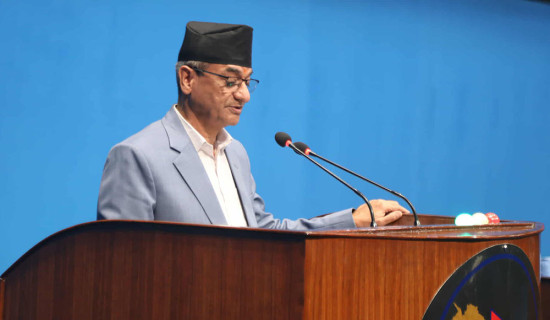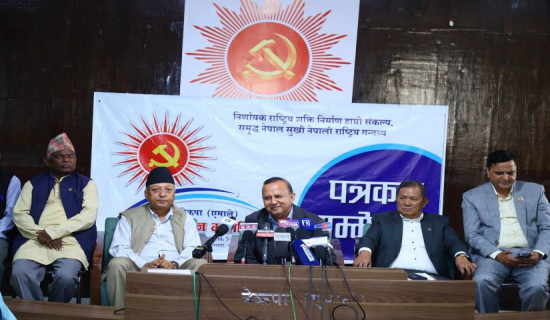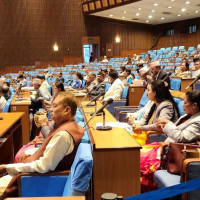- Thursday, 4 September 2025
Know the science behind sleep paralysis
By Arpana Adhikari,Kathmandu, July 6: Just two days ago, 23-year-old management student Sashank Dhakal from Basundhara faced a chilling episode. “I felt a heavy pressure on my chest, like I was being choked. I saw someone sitting behind me, silent and shadowy. Suddenly, that person pressed my chest. I was frozen and I couldn’t scream,” he recalled, still shaken by the haunting memory.
Trapped in a half-conscious state, he struggled for minutes before finally breaking free.
This was not his first encounter. For the past three years, he has faced such episodes on and off. His mother believing it to be ‘Aaithan’, a result of supernatural attack, advised him to keep a knife or metal object under his pillow and chant the Hanuman Chalisa. But nothing has helped.
He isn’t alone in this maze.
Sumita Tamang, a journalist at Radio Nepal, has experienced a similar sensation for years. “It’s like a hallucination. I know I’m dreaming but I cannot move. My eyes are open, but my body is paralysed. Sometimes, I feel like I’m dying. It’s terrifying, like being attacked by a dark force,” she shared.
She said sensation often lasts minutes and fills her with fear and a deep sense of separation from loved ones. Interestingly, she only experiences this during daytime naps. When she once shared her experience with her now late mother, she was advised to chant mantras, and Tamang says it actually helped.
Muna Luitel, 50 from Chandol, recalls first experiencing ‘Aaithan’ at age of 13, while visiting her sister in Changunarayan. Since then, the episodes have recurred from time to time.
She describes seeing a multicoloured ball of light each time pressing on her chest, leaving her completely paralyzed. She cannot even call out to her husband sleeping beside her.
“It feels like the light traps me completely. I can’t move an inch and feel suffocated,” she said, adding the fear lingers for days after each episode.
This isn’t just the story of Dhakal, Tamang or Luitel. If you ask people around you, family, neighbours or friends, chances are, at least one or two have had similar experience.
Some go through it frequently, while others have faced it only once or twice in their lifetime. People have explained that during an episode of sleep paralysis, they have seen or sense things that are not actually there.
According to the National Institutes of Health (NIH) USA, about 8 per cent of people have experienced sleep paralysis at least once in their life.
Research shows that students are more likely to experience sleep paralysis compared to others. Around 28-34 per cent students have experienced sleep paralysis at least once, compared to about 8 per cent in the general population.
These creepy encounters, often considered as superstition or evil attacks like ‘Aaithan’ are, in fact, a recognised phenomenon known as sleep paralysis, said Dr. Suresh Adhikari, a psychiatrist at Patan Hospital.
Often misunderstood as paranormal phenomenon
Sleep paralysis is a real and scientifically explained sleep disorder, yet it is often misunderstood as a supernatural event. People often associate it with evil spirits, curse, dark energy and attack of witches.
Muna Luitel explained, when she first gets the sleep paralysis, her sister explained to her that it happened because she had entered the frontyard of a man in their village believed to practice witchcraft. Since then, she associated the experience with dark energy and spiritual attacks.
Like Luitel, Devi Dhakal, Shashank’s mother also believed sleep paralysis is a paranormal experience, something she had heard about since her childhood.
To rid her son of it, she performed several rituals, convinced it was caused by ancestral spirits with unfulfilled desires.
Science behind sleep paralysis
Sleep paralysis is a temporary inability to move or speak while falling asleep or waking up.
Dr. Adhikari explained the phenomenon in a video shared on his TikTok account. “What many people in Nepal call ‘Aaithan’ is actually sleep paralysis,” he said. “It feels like something heavy is pressing on the chest. People often associate it with a supernatural presence in the room,” he said.
Dr. Adhikari explained that sleep occurs in two main stages, one is NREM (Non-Rapid Eye Movement), the first stage where the body relaxes and REM (Rapid Eye Movement), the second stage where dreaming occurs and the brain is highly active.
During REM sleep, to prevent us from physically acting out our dream, our brain naturally induces a temporary muscle paralysis. Normally, we wake up after REM sleep and this paralysis ends. But in some cases, a person may become conscious before the REM cycle is complete, meaning their mind is awake but their body remains frozen, explained Dr. Adhikari.
This creates a frightening sensation of being trapped or suffocated, often accompanied by vivid hallucinations, he added.
“Some people feel a weight on their chest, others find it hard to move or breathe and many report sensing a presence of unseen power nearby,” said Dr. Adhikari, adding “These episodes typically last from a few seconds to a couple of minutes.”
When is it a concern?
Occasional sleep paralysis is generally harmless. However, frequent episodes can be linked to underlying issues such as stress and anxiety, poor sleep quality and narcolepsy (a chronic sleep disorder where a person experiences extreme daytime sleepiness and falls asleep suddenly).
Can it be prevented?
There is no specific medication to treat sleep paralysis. However, reducing its trigger can help minimize episodes, Dr. Adhikari explained.
He recommended to follow universal sleep hygiene, in which one has to go to bed and wake up at the same time every day, ensuring a quiet, dark and cool sleep environment, avoiding use of electronic devices at least 30 minutes before bed and getting seven to nine hours of sleep each night.
Similarly, he asked to manage stress and anxiety by practicing techniques like meditation and deep breathing before bedtime and reducing alcohol and caffeine intake.
He also suggested to seek professional help if anxiety becomes overwhelming.
Informing that sleeping on the back has been linked to a higher chance of sleep paralysis, he said sleeping on your side may reduce the risk.
While sleep paralysis can be a horrifying experience, especially when misinterpreted as something supernatural, understanding its causes and adopting healthy sleep habits can significantly reduce its occurrence.
















